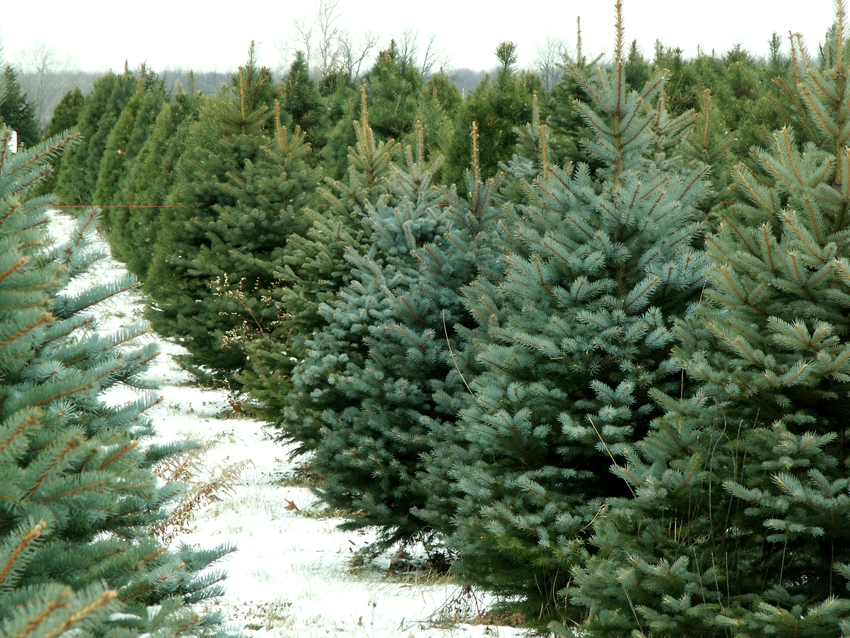Bought yours yet? If not, read on.
This weekend traditionally sees the biggest sale of Christmas trees, http://www.thehappygardeners.co.uk/ tell us what to look for when buying.
While there are advantages in an artificial tree, Christmas wouldn’t be the same without the real thing.
You can buy pre-cut trees, which have the obvious advantage of ease. There are always hundreds to choose from, usually bundled up in mesh so they’re easy to carry home and put up.
The down side to pre-cut trees is that they were probably cut long before they appear at nurseries, which is often weeks before Christmas. You are also usually limited as to variety of tree, the bulk of pre-cut trees being some type of balsam. If you are set on a particular variety of evergreen, such as a Douglas fir, you may have to pay top dollar.
Cutting your own Christmas tree means it will be fresh. It should retain its needles longer than a pre-cut tree and will probably even add more evergreen scent to your home.
The looming drawback to cut your own is that, as it says, you have to cut your own tree so take a sharp saw. Once it’s cut, you generally have to drag it back to your car, so keep that in mind when looking for the largest, fullest tree. Thankfully, many tree farms have begun realizing that most of us are not as rugged as we are sentimental, and they make the cut your own experience easier by assisting and having sleighs or wagons available to cart the tree to your car.
I have never in my life been brave enough to cut down my own Christmas tree.
Finally, the drawback to both pre-cut and cut your own trees is that because they’re dead they are slowing drying out, dropping needles all over your floor and your presents. And the drier they get, the more of a fire hazard they are. Don’t you love still finding the needles in July?
The final choice is a live tree. If you live in an area with mild winters, there are probably potted or balled and burlaped (B and B) trees available all year. If your local garden centres ship off their nursery stock before the holidays, you may need to have pre-ordered a live tree or even bought it during the growing season.
Live trees will, of course, be the freshest choice. Depending on the size of your tree, you can move it in and out of your home and reuse it, or plant outside and maybe decorate for the holiday.
There are many types of Christmas trees, each with their own advantages. For example, the Nordmann fir has lush green needles making it easy to decorate and the strong branches will support your lights and decorations to create an excellent display. The Noble fir’s soft green-blue needles, neat compact branches and wonderful aroma make this tree a strong choice for the home.
The Fraser fir, often sold with f cones still attached, has a gorgeous citrus scent, dark green foliage and strong branches. It tends to grow with a compact, upright habit making it a good choice for smaller rooms.
The Norway spruce is the ‘traditional’ Christmas tree. Strong branches make for easy decorating, although the needles can be fairly sharp and will drop, especially in heated rooms. Therefore keep this one outside for as long as possible, then bring in to an un-heated or cool room for best needle retention.
The Blue spruce is more of a blue-grey colour, whose strong branches and rich festive scent combine with good needle retention. They often have a wide base, making a perfect place to hide presents
The Scots pine has strong branches and will fill any room with a pine perfume throughout the festive season.
All live trees need a great deal of maintenance so if you’re choosing one first measure your space.
When choosing your tree do a branch/needle test for freshness and look for other indicators of dryness or deterioration.
Finally, think about what type of decorations you will be using and always think of safety:
– Never place your tree near a heat source, such as a fireplace or portable heater.
– If you have small children or pets, trim the lower branches to avoid eye injuries.
– Hang all ornaments that are breakable, have small, detachable parts or metal hooks, or that look like food on higher branches where small children can’t reach them. Florist’s wire, which can be twisted firmly around branches, is a great way to hang fragile ornaments.
– Keep pets out of the room in which the tree is placed, especially if you can’t be there to supervise. Cats are notorious for leaping onto Christmas trees, especially when pursued by another pet.
– Avoid using artificial snow sprays, which can cause lung irritation if inhaled.
– Turn off tree lights when you go to bed or leave the house. Use only UL-approved electrical decorations and extension cords, and check that no cords have frayed since you last used the lights.
– Never burn Christmas-tree branches in your fireplace. It can cause the build-up of creosote, a highly flammable compound.
When you buy your tree, have an inch cut off the base to make it easier for the tree to take in water and if you don’t plan to put the tree up right away, place it in a bucket of warm water and stand it in an unheated garage or porch away from the wind and cold.
Keep your tree well watered. Water prevents the needles from drying and dropping off and maintains the fragrance. Trees may use several litres a day, so check the water level in the stand every few hours. Never let the water level fall below the base of the tree or the cut end may seal over, preventing further water intake.
Happy Christmas!
